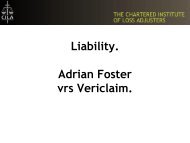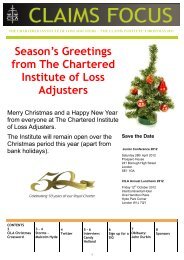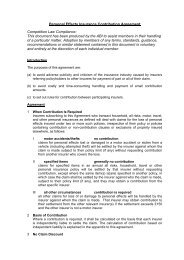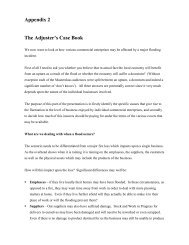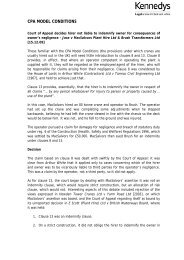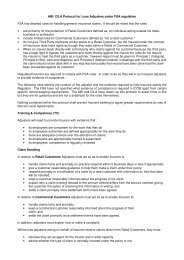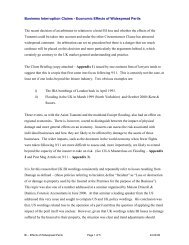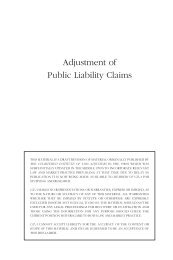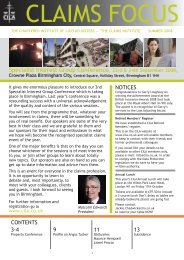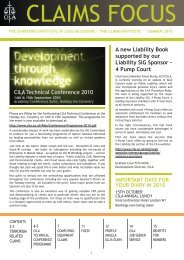Proximate Cause
Proximate Cause
Proximate Cause
- No tags were found...
Create successful ePaper yourself
Turn your PDF publications into a flip-book with our unique Google optimized e-Paper software.
THE PRINCIPLES OF INSURANCEPROXIMATE CAUSE
CILACH 1 Introduction to the Insurance Industry46
The Principles of Insurance<strong>Proximate</strong> <strong>Cause</strong>8. THE PRINCIPLES OF INSURANCE PROXIMATE CAUSEContents8.1 <strong>Proximate</strong> <strong>Cause</strong> Definition8.2 Other Considerations8.3 Burden of Proof in Relation to <strong>Proximate</strong> <strong>Cause</strong>8.4 Key Points to RememberIntroductionInsurance Policies only provide cover for loss or damage if it is as a result of one of theperils listed in the Policy. Determining the actual cause of loss or damage is therefore afundamental step in the consideration of any claim.<strong>Proximate</strong> cause is a key principle of insurance and is concerned with how the loss ordamage actually occurred and whether it is indeed as a result of an insured peril.This section provides a definition of proximate cause and explains how it should bedetermined in practice.8.1 <strong>Proximate</strong> <strong>Cause</strong> Definition<strong>Proximate</strong> cause was defined in the case of Pawsey v Scottish Union & National InsuranceCompany (1908) as:the active and efficient cause that sets in motion a train of events which bringsabout a result, without the intervention of any force started and working activelyfrom a new and independent source.ActivityUse a dictionary to look up the meaning of the word <strong>Proximate</strong>. Look forother words in a thesaurus that might assist you in explaining the termproximate cause to a Policyholder or colleague.The important point to note is that the proximate cause is the nearest cause and not aremote cause.Unfortunately when a loss occurs there will often be a series of events leading up to theincident and so it is sometimes difficult to determine the nearest or proximate cause. Letus consider the following scenario:Jim, a guitar player in a local band, plays at a gig on a Sunday evening. The gig goeswell and an encore is demanded by the crowd. The encore is played but as a resultJim finishes later that he expected and misses the train home. Jim then has to take abus home and does not get to bed until 01:30 am. In the morning he oversleeps due totiredness and because he had forgotten to put his alarm on. Jim is now in a hurry andquickly makes his breakfast, including toast which he puts under the grill. The postmanthen arrives and rings the bell (Jim has normally left long before the postman arrives.)The postman engages in a long conversation with Jim who eventually returns to thekitchen to find that the toast has ignited setting alight a tea towel. The tea towel in turnhas scorched the kitchen table.47
CILACH 1 Introduction to the Insurance IndustryJim is not worried about the tea towel or the toast but submits a claim for the table. Fireis covered by the Policy and the proximate cause of the loss must be established. Thecause of the loss could be:1. Playing at the gig2. The fact the encore was demanded3. Missing the train home4. Going to bed late5. Omitting to set the alarm6. The arrival of the postman7. The long conversation with the postman8. The ignition of the toast9. The ignition of the tea towels.Referring back to the definition in Pawsey v Scottish Union (1908), we have to find theactive efficient cause that sets in motion the chain of events. Arguably, playing the gig(1) set in motion the chain of events. Playing a gig is not normally an insured peril and soif that was determined to be the proximate cause there would be no cover for the damageto the table.However, the definition in Pawsey v Scottish Union (1908) goes on without theintervention of any force acting independently from a new and independent force. Allcauses from 2 to 7 are new forces acting independently from new and independent forcesso we can forget all prior causes in the chain. The ignition of the toast (8) and the ignitionof the tea towels (9) are the closest causes and therefore appear to fit most comfortablywith our definition in Pawsey v Scottish Union (1908). They are not remote causes.The decision now is whether the ignition of the toast and tea towels constitutes fire asmeant by the Policy and, if yes, whether there are any relevant exclusions. (The definitionof fire will be discussed later in the course but it can be noted that the fire peril hasoperated in this instance.)ActivityReview a sample of claims and look at the sequence of events leading tothe loss or damage. Decide what the remote causes are, highlight newand independent forces and identify the closest cause. This will be theproximate cause.8.2 Other ConsiderationsIt is important to note that the proximate cause need not be the cause immediately beforethe loss or damage occurs. The last cause could simply be a link in the chain connectingthe event with the proximate cause. For example, a fire might cause a water pipe toburst. Despite the resultant loss being water damage, the fire would still be the proximatecause of the incident.8.3 Burden of Proof in Relation to <strong>Proximate</strong> <strong>Cause</strong>In the majority of claims, the cause is obvious and so it is relatively easy to establishwhether it is a peril covered by the Policy. Difficulties arise when there are exceptions inthe Policy or when more than one cause has operated and not all are covered. As already48
The Principles of Insurance<strong>Proximate</strong> <strong>Cause</strong>discussed, the proximate cause must be identified before it is possible to decide whetherthe loss or damage is covered by the Policy.There is a general rule that applies to the burden of proof. The Policyholder mustdemonstrate that an insured peril has caused the loss or damage and, having done so, itis then for the Insurer to demonstrate the operation of any exclusion (if they wish to denypolicy liability).The situation is slightly different with an All Risks Policy. In this instance, the Policyholderneed only demonstrate that damage has occurred to the insured property during theperiod of insurance. If an Insurer wishes to apply an exclusion, the Insurer must then provethat the cause was one of the excluded events.If one or more perils have operated and one or more of these perils are covered by thePolicy, the resultant loss or damage will be covered. However, in some cases that is notthe end of the matter as different excesses may apply to the various perils concerned. Youwill then need to make a decision as to under which peril to pay the claim (and thereforewhich excess to apply). Be aware that your choice of peril can have repercussions forreinsurance or dual insurance matters.ActivityConsider an escape of water claim. What types of proof could an Insuredprovide to demonstrate that the damage is as a result of an escape ofwater? Now do the same exercise for a storm claim.8.4 Key Points to RememberYou must establish proximate cause in order to decide whether a claim is covered bythe Policy.<strong>Proximate</strong> cause is defined as the active and efficient cause that sets in motion atrain of events which brings about a result, without the intervention of any forcestarted and working actively from a new and independent source.The Policyholder is required to demonstrate that an insured peril has caused the lossor damage claim. If the Insurer then wants to reject the claim, they must demonstratethat an exclusion applies.49
CILACH 1 Introduction to the Insurance Industry50



